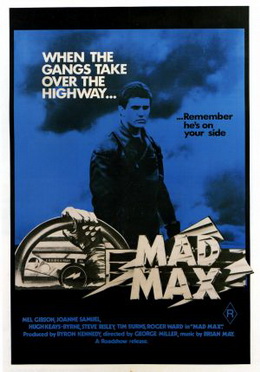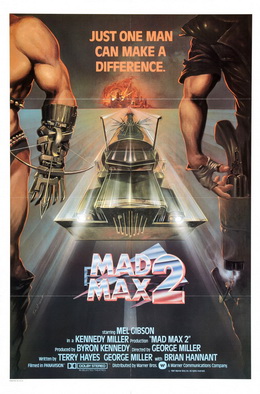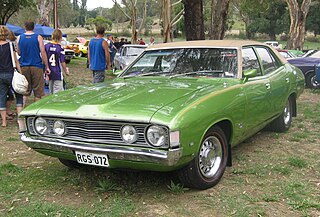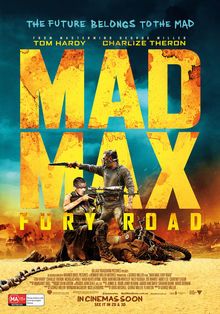
Mad Max is a 1979 Australian dystopian action film directed by George Miller, who co-wrote the screenplay with James McCausland, based on a story by Miller and Byron Kennedy. Mel Gibson stars as "Mad" Max Rockatansky, a police officer turned vigilante in a dystopian near-future Australia in the midst of societal collapse. Joanne Samuel, Hugh Keays-Byrne, Steve Bisley, Tim Burns and Roger Ward also appear in supporting roles.

Mad Max 2 is a 1981 Australian post-apocalyptic dystopian action film directed by George Miller, who co-wrote it with Terry Hayes and Brian Hannant. It is the second installment in the Mad Max franchise. The film stars Mel Gibson reprising his role as "Mad Max" Rockatansky and follows a hardened man who helps a community of settlers to defend themselves against a roving band of marauders. Filming took place in locations around Broken Hill, in the Outback of New South Wales.

The Ford Falcon is a full-size car that was manufactured by Ford Australia from 1960 to 2016. From the XA series of 1972 onward, each Falcon and range of derivates have been designed, developed, and built in Australia, following the phasing out of the American-influenced Falcon of 1960 to 1971, which had been re-engineered locally as the XK to XY series for the harsher Australian conditions. The luxury-oriented Ford Fairmont model joined the range from 1965. Luxury long-wheelbase derivative versions called the Ford Fairlane and LTD arrived in 1967 and 1973 respectively with production ending in 2007.

Ford Performance Vehicles was the Melbourne-based, premium performance arm of automobile manufacturer Ford Australia. The company produced a range of Ford-based models from 2002 to 2014 under the FPV marque name.

Max Rockatansky is the title character and antihero protagonist of the Australian post-apocalyptic action film series Mad Max. Created by director George Miller and producer Byron Kennedy, the character was played by actor Mel Gibson in the first three films from 1979 to 1985, by Tom Hardy in the fourth film in 2015, and by Jacob Tomuri in the fifth film in 2024.

The Cars of the Stars Motor Museum was in the English town of Keswick, Cumbria, and owned a collection of celebrity television and film vehicles. The museum opened in 1989 and closed in 2011. The sister site The Bond Museum in Keswick, with its over 30 original screen cars from the James Bond films, also closed at the same time.

Hugh Keays-Byrne was a British-Australian actor. Between 1968 and 1972 he was a member of the Royal Shakespeare Company. He played the antagonist in two films from the Mad Max franchise: Toecutter in Mad Max, and Immortan Joe in Mad Max: Fury Road.

The Ford Falcon (XA) is a full-size car that was produced by Ford Australia from 1972 to 1973. It was the first iteration of the third generation of the Falcon and also included the Ford Fairmont (XA)—the luxury-oriented version. The XA platform was also used for the Australian Ford Landau.

The Ford Falcon (XB) is a full-size car that was produced by Ford Australia from 1973 to 1976. It was the second iteration of the third generation of the Falcon and also included the Ford Fairmont (XB), the luxury-oriented version.

The Ford Falcon GT is an automobile produced by Ford Australia from 1967 until 1976 as the performance version of its Falcon model range. Its production was resumed by a joint venture in 1992 and 1997 with Tickford, and then again between 2003 and 2014 with Prodrive, the latter being marketed as the FPV GT & GT-P. The Falcon GT is inextricably linked with the history of Australian sports sedan car production and with the evolution of Australian motor racing.The Falcon GT lineage includes many Bathurst wins and motorsport accolades over its entire production run.

Mad Max is a media franchise created by George Miller and Byron Kennedy. It centers on a series of post-apocalyptic and dystopian action films. The franchise began in 1979 with Mad Max, and was followed by three sequels: Mad Max 2, Mad Max Beyond Thunderdome (1985) and Mad Max: Fury Road (2015); Miller directed or co-directed all four films. Mel Gibson portrayed the title character Max Rockatansky in the first three films, while Tom Hardy portrayed the character in Mad Max: Fury Road.
The Mad Max series of films, which debuted in 1979, has had a significant impact on modern popular culture. Mad Max references are deeply embedded in popular culture; references to its dystopian, apocalyptic, and post-apocalyptic themes and bizarre landscape and desolate wasteland imagery have inspired some artists to emulate the look and feel of some aspect of the series in their work.

Mad Max: Fury Road is a 2015 Australian post-apocalyptic action film co-written, co-produced, and directed by George Miller. Miller collaborated with Brendan McCarthy and Nico Lathouris on the screenplay. The fourth instalment in the Mad Max franchise, it was produced by Village Roadshow Pictures, RatPac-Dune Entertainment and Kennedy Miller Mitchell, and distributed by Roadshow Entertainment in Australia and by Warner Bros. Pictures internationally. The film stars Tom Hardy and Charlize Theron, with Nicholas Hoult, Hugh Keays-Byrne, Rosie Huntington-Whiteley, Riley Keough, Zoë Kravitz, Abbey Lee, and Courtney Eaton in supporting roles. Set in a post-apocalyptic desert wasteland where petrol and water are scarce commodities, Fury Road follows Max Rockatansky (Hardy), who joins forces with Imperator Furiosa (Theron) against cult leader Immortan Joe (Keays-Byrne) and his army, leading to a lengthy road battle.

Mad Max is a 2015 action-adventure video game developed by Avalanche Studios and published by Warner Bros. Interactive Entertainment. Based on the Mad Max franchise, the game follows Max Rockatansky as he progresses through the wasteland building a vehicle, the Magnum Opus, to battle against a gang of hostile raiders led by Scabrous Scrotus and reach the storied "Plains of Silence", where he hopes to find peace. Mad Max emphasizes vehicular combat, in which players can use weapon and armor upgrades on their car to fight enemies. It is set in an open post-apocalyptic wasteland consisting of deserts, canyons, and caves.
Joshua Helman is an Australian actor. He is best known for playing Slit in the action film Mad Max: Fury Road (2015), William Stryker in the superhero film X-Men: Days of Future Past (2014) and its sequel X-Men: Apocalypse (2016), and Scabrous Scrotus in the action film Furiosa: A Mad Max Saga (2024). He has also appeared in several television series, as well as the films Jack Reacher (2012), Monster Hunter (2020), and Thirteen Lives (2022).

Imperator Furiosa Jabassa is a fictional character in the Mad Max franchise. Introduced in Mad Max: Fury Road (2015) and portrayed by Charlize Theron, she serves as an officer in Immortan Joe's army but turns against him in order to free "The Five Wives", Joe's female sex slaves. During her journey, she meets Max Rockatansky. Despite initial hostility, the two become allies and team up to drive The Five Wives to a safe environment called the "Green Place".

Mad Max: Fury Road is a limited comic book series created by George Miller, Nico Lathouris and Mark Sexton. Serving as a prequel to the 2015 film of the same name, in addition to bridging the events of the film with the 1985 film Mad Max Beyond Thunderdome, the series focuses on several characters from the film at various points in their lives before it.

The Miami Auto Museum at the Dezer Collection was a privately owned museum in North Miami, Florida, that exhibited automobiles and related memorabilia collected by Michael Dezer. It has closed and is being moved to Orlando, Florida, to be opened as the Orlando Auto Museum.

Immortan Joe Moore is a fictional character and the main antagonist of the 2015 film Mad Max: Fury Road. He is portrayed by Hugh Keays-Byrne, who previously portrayed the Toecutter in the original Mad Max. Immortan Joe also appears in the 2015 prequel comic series of the same name, and the 2024 prequel film Furiosa: A Mad Max Saga, portrayed by Lachy Hulme.



















